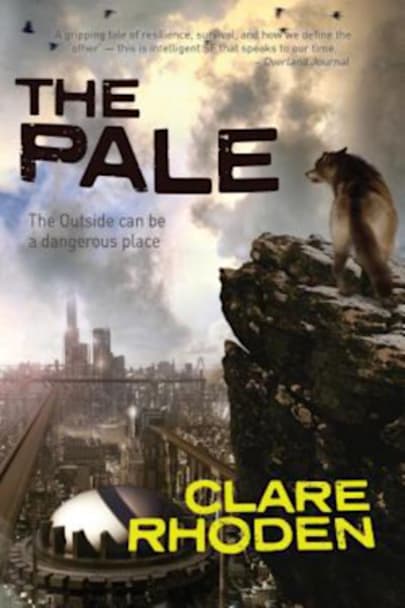The Outside can be a dangerous place. But so can the inside. It’s been years since the original cataclysm, but life has been structured, peaceful, and most of all uneventful in the Pale. The humachine citizens welcome the order provided by their ruler, the baleful Regent. However, when one of their own rescues a human boy, Hector, from ravenous ferals on the Outside, their careful systems are … turned upside down. As Hector grows more and more human-strange, the citizens of the Pale grow uneasy. What will happen when the Outside tries to get in?
more



Riveting dystopian fiction
When reading the first in this series of three books by Clare Rhoden, I felt a bit like an anthropologist experiencing culture shock in the course of doing fieldwork among a little known culture. In fact, she created four complete sets of cultural contexts, that is, four very different sets of communities trying to survive in the aftermath of a major cataclysmic event. These are the humachines, the tribes, the people living in what was called the settlement, and the canini, a world of canines with an ability to communicate through mindspeak. The connecting link is Hector, a young man who had been orphaned only to be raised in a society of people altered and enhanced by technology to such an extent that they are described as humachines by members of the other societies. The world building is phenomenal, with vivid details injected into the story.
The author has created a fascinating, multilayered, and complex world. At times, I felt a bit overwhelmed, bouncing around among the various cultures. But that is not a criticism; if one sticks with this book, one is richly rewarded. Several themes are raised throughout the book—the challenges of communication among groups with entirely different cultural expectations, questions of ethics, for instance in regard to population control as well as exploitation of labor, and questions of what makes a viable community. Throughout the reader is reminded that cultures change constantly and that some patterns of behavior that may have been adaptive at a certain point in time need to be reconsidered. Just like anthropologists have repeatedly discovered in the course of such fieldwork, the strange and inexplicable after a while becomes more comprehensible at the same time as one finds a number of familiar patterns of behavior and cultural dynamics. The “other” is not as different from oneself as one might think.
The Pale is a wonderful book. It took me through the best and worst of times for the characters and how they came together to take back the land from an Apocalypse setting. Very well written and kept me looking forward to my reading time. I enjoyed this book and I am sure you will too.
Imagine a landscape more forbidding than Central Australia, the Sahara, the Atacana desert. A landscape still shifting with the after shocks of a cataclysmic event that, 197 years before The Pale begins, destroyed most species. Clare Rhoden quickly establishes this ghastly world in our minds. At the same time she moves the narrative along with fascinating characters to care about.
I particularly liked the depiction of how the mentality, society and even biology of humans could evolve to accomodate the need to survive and also to try to eliminate the weaknesses and disasters of Pre-Cataclysm humanity. In some dystopian stories all we really see, I think, is the last angry male humans mindlessly fighting each other to the last club and bullet. Here, to my relief, and I’m sure yours too, we have leaders, mostly female, relying on mutual respect, discussion, and the cross seeding of ideas between groups. This intelligent and thought provoking series looks at how the best attributes of we humans, empathy, hope, kindness, can have the power to lift us above struggle and misery.
The Pale centres around the fallout from a cataclysmic earthquake, which affects many different groups in a post-apocalyptic society: settlers, tribes, canini, and the modified humans of the Pale.
The Pale itself is a walled city populated with humachines: humans who have been augmented with technology in order to become more efficient citizens. Genetic breeding is commonplace. Those who are no longer considered worthy of ‘upgrades’ are ‘recycled’, and this is considered perfectly normal to the inhabitants of the Pale. The fortress-like city is run by a Regent devoid of empathy, who rules with a tyrant’s fist.
In true dystopian style, The Pale looks into the future to show where our own obsession with technology might lead us. A thought-provoking read reminiscent of George Orwell’s Nineteen Eighty-Four and Philip K. Dick’s Do Androids Dream of Electric Sheep? The Pale raises many questions as to what it truly means to be human.